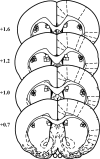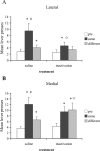Inactivation of the lateral but not medial dorsal striatum eliminates the excitatory impact of Pavlovian stimuli on instrumental responding
- PMID: 18094235
- PMCID: PMC6673531
- DOI: 10.1523/JNEUROSCI.4097-07.2007
Inactivation of the lateral but not medial dorsal striatum eliminates the excitatory impact of Pavlovian stimuli on instrumental responding
Abstract
Conditioned stimuli are important guides for behavioral actions. This experiment determined the role of the dorsal striatum in conditioned-stimulus modulation of instrumental responding using the pavlovian-instrumental transfer (PIT) paradigm. Rats received pavlovian training wherein two different auditory stimuli predicted the delivery of two food rewards. Next, rats were trained to perform two instrumental actions earning the same two rewards. Finally, the impact of pavlovian stimuli on instrumental performance was assessed in extinction: the stimuli were periodically presented while rats were free to perform the lever-press response. Before testing, medial or lateral dorsal striatum was infused with saline or baclofen/muscimol, to temporarily inactivate the region. Under saline, outcome-selective PIT was observed: presentation of a stimulus paired with the same outcome as the instrumental action elevated responding, whereas presentation of a stimulus paired with a different outcome did not. Inactivation of the dorsolateral striatum dramatically reduced this effect. Inactivation of the dorsomedial striatum left intact the ability of reward-related stimuli to invigorate responding; however, the selectivity of the stimulus effect was lost (i.e., both stimuli excited responding). These results indicate that subregions of the dorsal striatum play distinct roles in stimulus modulation of instrumental performance with the lateral region being vital for reward-related stimuli to excite responding and the medial region being involved in the integration of stimulus-reward associations with specific response-outcome associations to produce selective responding. These findings identify new roles for the dorsal striatum in mediating the incentive effects of reward-predictive stimuli on behavioral actions made to obtain reward.
Figures


References
-
- Adams S, Kesner RP, Ragozzino ME. Role of the medial and lateral caudate-putamen in mediating an auditory conditional response association. Neurobiol Learn Mem. 2001;76:106–116. - PubMed
-
- Aosaki T, Graybiel AM, Kimura M. Effect of the nigrostriatal dopamine system on acquired neural responses in the striatum of behaving monkeys. Science. 1994;265:412–415. - PubMed
-
- Barnes TD, Kubota Y, Hu D, Jin DZ, Graybiel AM. Activity of striatal neurons reflects dynamic encoding and recoding of procedural memories. Nature. 2005;437:1158–1161. - PubMed
-
- Beckstead RM, Domesick VB, Nauta WJ. Efferent connections of the substantia nigra and ventral tegmental area in the rat. Brain Res. 1979;175:191–217. - PubMed
Publication types
MeSH terms
LinkOut - more resources
Full Text Sources
Other Literature Sources
